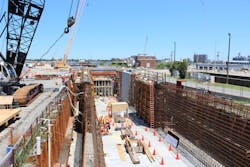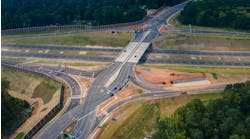When concrete is in the doghouse, tender loving care is at an all-time high.
It is perhaps the most critical point in the entire pour, one where all elements join together and attempt to harmonize. Those involved in the Elizabeth River Crossing project, which is this year’s No. 1 on the Roads & Bridges Top 10 Roads list, are well aware of the matrimony that needs to take place. To date, six segments of the massive tunnel tubes—complete with a floor and the doghouse (where they pour the walls and roof of the tunnel)—are now complete.
The final five pieces—each are about 342 linear ft in length, 54 ft wide and 28.5 ft tall—are currently under construction in a dry dock in Baltimore. But it’s when the doghouse and floor come together for a lifelong bond that the process turns a little sensitive. Mass cooling and mass heating happen virtually at the same time. When the floor is being formed, piping running cold water is circulated through to remove some of the heat generated by the large volume of concrete. When crews pour the doghouse mass cooling also is used, but the floor is being mass heated as well.
“The reason for that is we want to match growths of the concrete, and when they cool off we want them to cool off in a similar fashion that creates higher quality concrete and increased durability,” Wade Watson, project director for the joint venture of Skanska, Kiewit and Weeks (SKW), which is the design-build contractor for the Elizabeth River Crossing project, told Roads & Bridges.
SKW wanted to get on the right path to a high-quality concrete mix from the start, so it went through a long experimental phase (about 9-12 months of planning, designing and testing) and worked through about 120 different recipes before coming up with the right combination. Sample pours and mockups were done in the field, including a full-size tunnel section about 70 ft long.
“We used all of that data to refine [the mix] and to come up with the best concrete mix that we could achieve,” said Watson.
“The secret to the mix is controlling the ultimate heat of hydration and the ultimate temperature of the concrete, so we do that by trying to produce a concrete product with a low heat and we also use nitrogen in our mix to super-cool the mix before it is placed.”
The concrete was designed to reach a 6,000-psi strength, but Watson said they were in the 9,000- to 10,000-psi range after a 28-day cure. The intense preplanning allowed for the first round of pours to go rather smoothly, and in June the first six segments traveled by tugboat to the jobsite in Virginia. At press time they were being prepped for their final immersion in the Elizabeth River. During the final stage, about 3 ft of ballast concrete is poured in the bottom of each piece, which allows crews to shape the curvature of the tunnel and adds more weight for final immersion. Ballast tanks, located on each corner of the segment, will then be filled with water, and the entire section will be lowered to its final resting place, which could be as deep as 95 ft. A temporary bulkhead on each end seals the segment from water migration, and once it is joined with another there is a large rubber gasket that creates the first seal. Crews will install another rubber seal—called the Gina gasket—between the two bulkheads before the bulkheads are ultimately removed. After water is removed from the joint, a secondary inner connection (Mega gasket) is applied. Both the Gina and Mega gaskets are covered by a concrete ring for a third seal.
When complete, the new tunnel will carry two lanes of eastbound traffic, while the existing tunnel will handle westbound traffic.
No subtle approach
The approaches on the Portsmouth, Va., and Norfolk, Va., sides also are currently under construction. The approaches are made up of two sections—a boat section and a cut-and-cover section. The boat section is essentially made up of retaining walls, while the cut-and-cover serves as the opening of the tunnel and mates with the first tube section. The first section will be placed on the Portsmouth side, and in September the approach was 80% complete, with the cut-and-cover finished. Sheets from the tie-in to the tube section also were being removed. The Norfolk side is about six months behind work in Portsmouth.
Approach work could be considered some of the most challenging on the Elizabeth River Crossing site. The main element of complexity is it basically abuts right up to the existing tunnel approaches, and a primary concern is to not disrupt the existing tunnels. So SKW came up with a supportive excavation system, which consists of 50-ft-deep beefed-up cofferdams where work is performed.
“We wanted to beef it up to the point where we could limit deflection or bending of the sheets so that we did not incur any ground movement,” said Watson.
Monitoring devices are in place to detect any shifting of sheets, the movement of soil between the sheets or the movement of existing tunnels themselves. The tunnels also are equipped with robotic devices that run 24/7 and monitor movement; as of early September there had been no effects on the existing tunnel.
The Martin Luther King Expressway extension is another element of the Elizabeth River Crossing work and involves 1½ miles of bridgework that connects U.S. 58 with I-264. Work there has just begun, and SKW is using DBE and SWaM firms to take care of business. The job is divided into two sections—Contract A and Contract B. Contract A, the earthwork portion of the project, will be handled by Curtis Contracting. Contract B, the structural portion, belongs to Waterfront Marine.
The existing Midtown and Downtown tunnels also will be worked on. The fire life safety standards of the sections will be upgraded. The fire resistance will be increased from 20 Mw to 100 Mw. Electrical and mechanical systems also will be improved and there will be some structural repairs done.
U.S. 58, which runs through the Midtown Tunnel, and I-264, the route of the Downtown Tunnel, will be widened, but contracts have not been let.
The MLK Extension and existing Downtown Tunnel rehabilitation are supposed to be finished on Dec. 23, 2016, with the new Midtown Tunnel reaching substantial completion one day later. Rehab work on the existing Midtown Tunnel will be done on May 11, 2018. R&B
Project: Elizabeth River Crossing Project
Location: Portsmouth and Norfolk, Va.
Owner: Virginia DOT
Designer: Skanska, Kiewit and Weeks
Contractor: Skanska, Kiewit and Weeks
Cost: $1.2 billion
Completion Date: Spring 2018



